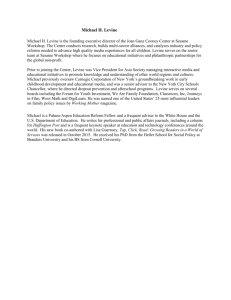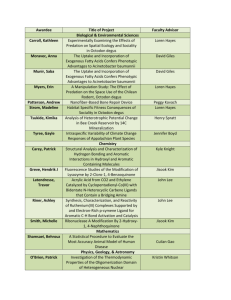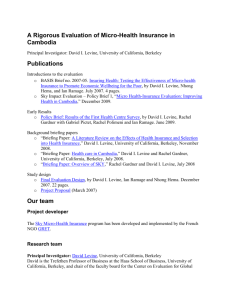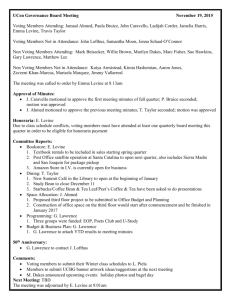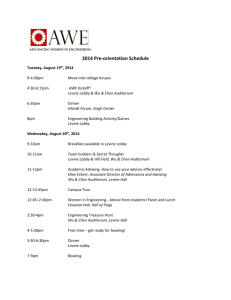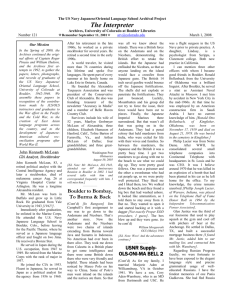The Interpreter - University Libraries
advertisement
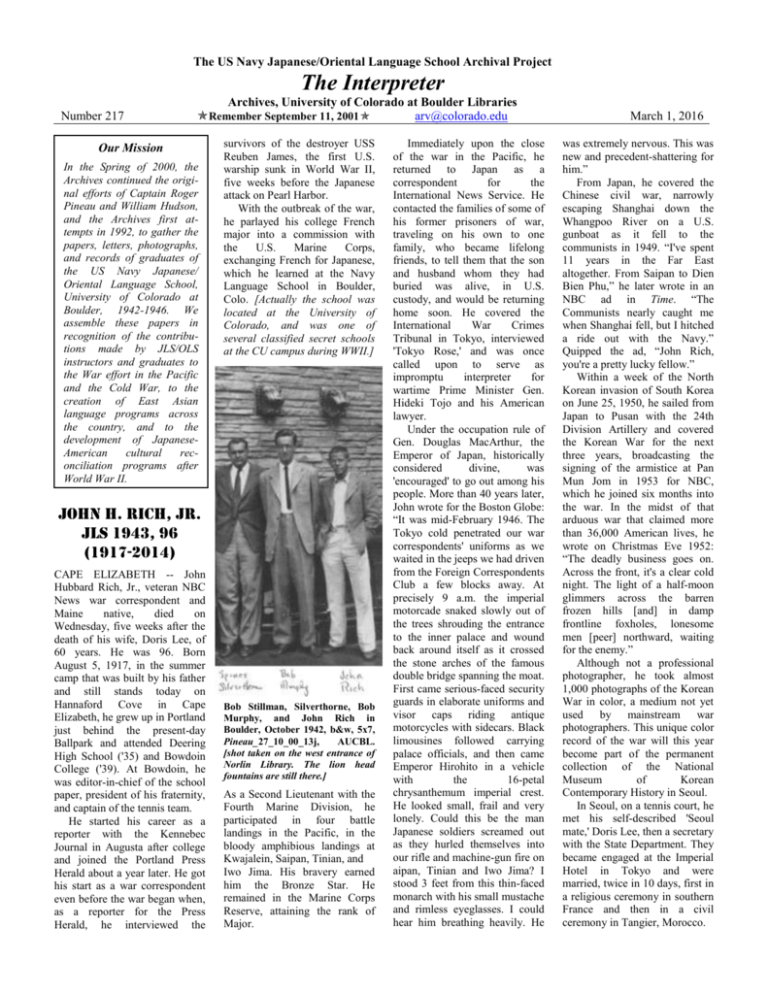
The US Navy Japanese/Oriental Language School Archival Project
The Interpreter
Number 217
Archives, University of Colorado at Boulder Libraries
Remember September 11, 2001
arv@colorado.edu
Our Mission
In the Spring of 2000, the
Archives continued the original efforts of Captain Roger
Pineau and William Hudson,
and the Archives first attempts in 1992, to gather the
papers, letters, photographs,
and records of graduates of
the US Navy Japanese/
Oriental Language School,
University of Colorado at
Boulder, 1942-1946. We
assemble these papers in
recognition of the contributions made by JLS/OLS
instructors and graduates to
the War effort in the Pacific
and the Cold War, to the
creation of East Asian
language programs across
the country, and to the
development of JapaneseAmerican
cultural
reconciliation programs after
World War II.
survivors of the destroyer USS
Reuben James, the first U.S.
warship sunk in World War II,
five weeks before the Japanese
attack on Pearl Harbor.
With the outbreak of the war,
he parlayed his college French
major into a commission with
the
U.S.
Marine
Corps,
exchanging French for Japanese,
which he learned at the Navy
Language School in Boulder,
Colo. [Actually the school was
located at the University of
Colorado, and was one of
several classified secret schools
at the CU campus during WWII.]
John H. Rich, Jr.
JLS 1943, 96
(1917-2014)
CAPE ELIZABETH -- John
Hubbard Rich, Jr., veteran NBC
News war correspondent and
Maine
native,
died
on
Wednesday, five weeks after the
death of his wife, Doris Lee, of
60 years. He was 96. Born
August 5, 1917, in the summer
camp that was built by his father
and still stands today on
Hannaford Cove in Cape
Elizabeth, he grew up in Portland
just behind the present-day
Ballpark and attended Deering
High School ('35) and Bowdoin
College ('39). At Bowdoin, he
was editor-in-chief of the school
paper, president of his fraternity,
and captain of the tennis team.
He started his career as a
reporter with the Kennebec
Journal in Augusta after college
and joined the Portland Press
Herald about a year later. He got
his start as a war correspondent
even before the war began when,
as a reporter for the Press
Herald, he interviewed the
Bob Stillman, Silverthorne, Bob
Murphy, and John Rich in
Boulder, October 1942, b&w, 5x7,
Pineau_27_10_00_13j,
AUCBL.
[shot taken on the west entrance of
Norlin Library. The lion head
fountains are still there.]
As a Second Lieutenant with the
Fourth Marine Division, he
participated in four battle
landings in the Pacific, in the
bloody amphibious landings at
Kwajalein, Saipan, Tinian, and
Iwo Jima. His bravery earned
him the Bronze Star. He
remained in the Marine Corps
Reserve, attaining the rank of
Major.
Immediately upon the close
of the war in the Pacific, he
returned to Japan as a
correspondent
for
the
International News Service. He
contacted the families of some of
his former prisoners of war,
traveling on his own to one
family, who became lifelong
friends, to tell them that the son
and husband whom they had
buried was alive, in U.S.
custody, and would be returning
home soon. He covered the
International
War
Crimes
Tribunal in Tokyo, interviewed
'Tokyo Rose,' and was once
called upon to serve as
impromptu
interpreter
for
wartime Prime Minister Gen.
Hideki Tojo and his American
lawyer.
Under the occupation rule of
Gen. Douglas MacArthur, the
Emperor of Japan, historically
considered
divine,
was
'encouraged' to go out among his
people. More than 40 years later,
John wrote for the Boston Globe:
“It was mid-February 1946. The
Tokyo cold penetrated our war
correspondents' uniforms as we
waited in the jeeps we had driven
from the Foreign Correspondents
Club a few blocks away. At
precisely 9 a.m. the imperial
motorcade snaked slowly out of
the trees shrouding the entrance
to the inner palace and wound
back around itself as it crossed
the stone arches of the famous
double bridge spanning the moat.
First came serious-faced security
guards in elaborate uniforms and
visor caps riding antique
motorcycles with sidecars. Black
limousines followed carrying
palace officials, and then came
Emperor Hirohito in a vehicle
with
the
16-petal
chrysanthemum imperial crest.
He looked small, frail and very
lonely. Could this be the man
Japanese soldiers screamed out
as they hurled themselves into
our rifle and machine-gun fire on
aipan, Tinian and Iwo Jima? I
stood 3 feet from this thin-faced
monarch with his small mustache
and rimless eyeglasses. I could
hear him breathing heavily. He
March 1, 2016
was extremely nervous. This was
new and precedent-shattering for
him.”
From Japan, he covered the
Chinese civil war, narrowly
escaping Shanghai down the
Whangpoo River on a U.S.
gunboat as it fell to the
communists in 1949. “I've spent
11 years in the Far East
altogether. From Saipan to Dien
Bien Phu,” he later wrote in an
NBC ad in Time. “The
Communists nearly caught me
when Shanghai fell, but I hitched
a ride out with the Navy.”
Quipped the ad, “John Rich,
you're a pretty lucky fellow.”
Within a week of the North
Korean invasion of South Korea
on June 25, 1950, he sailed from
Japan to Pusan with the 24th
Division Artillery and covered
the Korean War for the next
three years, broadcasting the
signing of the armistice at Pan
Mun Jom in 1953 for NBC,
which he joined six months into
the war. In the midst of that
arduous war that claimed more
than 36,000 American lives, he
wrote on Christmas Eve 1952:
“The deadly business goes on.
Across the front, it's a clear cold
night. The light of a half-moon
glimmers across the barren
frozen hills [and] in damp
frontline foxholes, lonesome
men [peer] northward, waiting
for the enemy.”
Although not a professional
photographer, he took almost
1,000 photographs of the Korean
War in color, a medium not yet
used by mainstream war
photographers. This unique color
record of the war will this year
become part of the permanent
collection of the National
Museum
of
Korean
Contemporary History in Seoul.
In Seoul, on a tennis court, he
met his self-described 'Seoul
mate,' Doris Lee, then a secretary
with the State Department. They
became engaged at the Imperial
Hotel in Tokyo and were
married, twice in 10 days, first in
a religious ceremony in southern
France and then in a civil
ceremony in Tangier, Morocco.
John is survived by his
daughter, Barbarine Rich, and
her husband, Toshio Okumura,
of Boston, Mass., by his son,
John H. Rich III, and his wife
Joanne Rich, of Falmouth, by his
son, Whitney Rich, and his wife
Kumiko Umemoto of Tokyo,
Japan, by his son, Nathaniel
Rich, and his wife Ming Hsu of
Hong Kong, China; by his
brother-in-law, Ralph Halstead,
and his wife Alice Halstead of
Hemet,
Calif.;
and
by
grandchildren Dylan, Madelaine,
Malcolm, Johnny, and Helene.
John Rich (l) With Irving R.
Levine in Korea during the peace
talks.
http://www.tvnewscheck.com/articl
e/75999/veteran-nbccorrespondent-john-h-rich-jr-dies
While starting a family, he
covered the French war in
Indochina, the 1955 Argentine
revolution, making the first radio
broadcast from revolutionary
headquarters in Mendoza, the
violent uprising of the forces of
Patrice Lumumba in the Belgium
Congo, and the raising of the
Iron Curtain in Berlin, where his
family of four children, two born
in Germany, lived 200 yards
from the barbed wire.
A reassignment to Paris
proved hardship duty after the
outbreak of the Algerian
Revolution and the subsequent
inhospitality of his miffed
French host who temporarily
refused to renew his press
credentials after a speech at the
National
Press
Club
in
Washington in January 1961
where he dared to say that
France faced the 'very real
possibility' of civil war over the
Algerian crisis. January 1961
was not lost altogether, however,
as that month he bought, for
$6,000, Bates Island in Casco
Bay, his refuge and great love
for the rest of his life.
From France, the family
moved to Tokyo where, as
NBC's Senior Correspondent in
Asia, for more than a decade he
covered the war in Vietnam,
Laos, and Cambodia and saw all
four children graduate from high
school. In 1971, he, his NBC
colleague Jack Reynolds, and
friend and fellow Mainer John
Roderick of the Associated Press
were allowed into China with the
'Ping Pong Delegation.' He
broadcast from Shanghai 22
years after his hasty retreat. A
year later, he accompanied
Nixon's trip to China. Following
that historic visit, in 1974, he
was awarded the Peabody
Award, the Overseas Press Club
Award for 'Best reporting from
Asia in any medium,' and an
honorary degree from Bowdoin
College at the age of 56.
At his Bowdoin 50th Reunion
address in 1989, he said: “My
job as a reporter gave me a
chance to live in many parts of
the world. It made me a realist,
but please don't think it made me
cynical. All the news is not bad.
One simple lesson was driven
home to me time after time.
When one gets to know people,
whatever their background,
nationality or racial origin, they
are basically alike. Penetrate the
surface differences and you learn
that they all want about the same
things that we do: freedom from
want, from fear; freedom to be
independent;
to
have
opportunity; to live lives without
excessive
government
interference; a chance to give
their children good educations.
I'm reminded of Hong Kong.
My wife was riding in a taxicab.
“Where are you from?” the
driver asked in halting English.
“America,” she said. He paused
a moment, thought, and then
said, “Lucky.””
John and D. Lee lived in the
moment. “One of my favorite
Japanese haiku has to do with
time. The haiku is that unusual
form of poetry of only 17
syllables, 5-7-5. It goes like this:
'Oh, so this is all - and she and I
had counted on a thousand
years.'”
Portland Press Herald/
Maine Sunday Telegram
Apr. 13, 2014
________________
Spoken with Pride
My father, Kurao Tsuchiya,
would have enjoyed reading The
Interpreter, as do my wife and
myself. He spoke with pride of
his days in Boulder contributing
to the war effort.
Keep up the good work.
Howard Tsuchiya
Son of Tsuchiya Sensei
________________
Elizabeth Jane Levine
JLS 1944 WAVE
June 7, 1922-May 20, 2014
Elizabeth J. "Betty" Levine, 91,
née Elizabeth Jane Billett,
widow of noted Japanese labor
relations expert, Solomon B.
Levine, died on May 20, 2014, in
Madison, Wisconsin of natural
causes.
Born
in
Lewistown,
Pennsylvania, Betty received her
BS
in
chemistry
from
Pennsylvania State University in
1942, a certificate from the
Harvard-Radcliffe
Business
Program in 1947, and her MA in
industrial relations from the
University of Illinois in 1965.
She met Solomon ("Sol") Levine
in 1943, while both were
learning Japanese at the Navy
Japanese Language School in
Boulder, Colorado. They were
married while still in the U.S.
Navy during WWII.
Betty's professional career
began as a Junior Chemist for the
Food and Drug Administration
from 1942 to 1945. During
World War II, she also worked
as a translator for military
intelligence. After the war, she
became the assistant director of
the
Harvard-Radcliffe
Management Training Program
from 1947 to 1948. From 1965
to 1969, she served as the
Assistant Director of the Institute
of Labor and Industrial Relations
at the University of Illinois.
Betty then worked as the
Assistant to the Chairman in the
Department of Psychology at the
University
of
WisconsinMadison from September 1969
to July 1987 where she was the
first non-faculty member to be
tenured. At her retirement, a
room was named in her honor.
Betty was also a passionate
activist during the Civil Rights
movement, and a volunteer for
the Democratic Party.
Interested parties may access
a public collection of documents
of Sol and Betty at the Univ. of
Colorado
at
http://184.168.105.185/archivegr
id/collection/data/492205876.
Roger Dingman interviewed
them for his book, Deciphering
the Rising Sun: Navy and
Marine Corps Codebreakers,
Translators, and Interpreters in
the Pacific War (Naval Institute
Press, 2009).
Preceding her in death were
her father Irving S. Billett,
mother Bertha S. Billett, brother
William Billett, and husband
Solomon B. Levine.
She is survived by her four
children author Jan Levine Thal,
musician Samuel B. Levine,
composer Michael A. Levine,
and Judge Elliott M. Levine; and
seven grandchildren, Jeremy
Thal, Sean Levine, Sybil Levine,
Mariana Barreto, Reed Levine,
Joshua Levine, and Zoe Levine.
http://www.informedchoicefunerals.c
om/obituary/125067/ElizabethLevine//
[Ed. Note: The Solomon and
Elizabeth Levine Papers were
donated to the Archives on July 19,
2000, and is organized, processed
and available. Its finding aid can be
found on Rocky Mountain Online
Archives
http://rmoa.unm.edu/.
References to the Levines can be
found in issues #05, #33, #53, 61a,
#68a, #106, #112, #121, #128, #151,
#182, and #210. They were active
and generous supporters of the
project.]
who influenced public education
nationwide, died last week at age
92.
________________
Golden L. Faris
USMC, OLS 5/12/45Golden
Leslie
Faris
89;
Indianapolis; passed away June
7, 2011. Born January 8, 1922 in
Indian Springs, IN to Golden
Wesley and Luna Pearl Lewis
Faris. Schooling: Ben Davis HS,
Indiana University and the
Japanese Language School at
University of Colorado and in
Stillwater, OK. Golden served in
the U.S. Marine Corps in the
South Pacific during WWII,
survived 4 landings, served as a
Japanese translator and received
a field commission. He was also
a Korean War veteran, became a
commanding officer in 1960 and
retired a Colonial. Golden's
career at the Indianapolis Star
began in the mail room and
spanned over 50 years between
active military duty periods.
Golden retired as Production
Director in 1996 and was highly
sought after as an industry
consultant. Golden was a 32Degree Mason of Lodge 162;
Scottish Rite, Fraternal Order of
Eagles and Murat Shrine
member; Life Member of
Military Officers of America and
Marine Corps Reserve; and held
other significant community
roles. In his youth, he was also a
successful
Golden
Gloves
fighter.
Survivors:
Deloris,
devoted wife of 69 years;
brother, Bob; son, Ron; loving
grand- and great-grandchildren.
He is preceded in death by son,
Edward.
http://flannerbuchanan.tributes.com/
show/Golden-Leslie-Faris-91666410
________________
Longtime WSU Dean,
Educator, JLS 1944
George Brain dies
PULLMAN, Wash. — George
Bernard Brain, the longtime dean
of the
Washington
State
University College of Education
As former colleagues heard
the news, they remembered
Brain’s formidable recall of
people
and
facts,
which
strengthened his role as a power
broker and passionate educator.
“George knew people all over
the country, from the U.S.
secretary of education to the
superintendents of very small
school districts,” said WSU
Associate Professor Dennis Ray.
“He just had a phenomenal
memory for people and their
career paths and for school law,
which was his real love,” said
Ray, for whom Brain served as
doctoral advisor. “In a seminar,
he’d bounce off names and dates
and court cases. I’m sure if we’d
had laptops, we would have been
sitting there Googling to see if he
was right. He always was.”
Brain was dean of the
College of Education from 1965
to 1983. Joanne Harkins was his
assistant at the end of his tenure
on the Pullman campus.
“He was friendly with
everyone, and knew everyone,”
said Harkins, now assistant to the
dean in the College of Science.
“He was from a generation of
administrators who actively
participated in improving the K12 schools around the state of
Washington
by
matching
principals and superintendents to
the right school districts. He
really cared.”
A quick rise into
school leadership
Brain was born on April 25,
1919, in the tiny Kittitas County
town of Thorp, Wash., where he
returned after his retirement from
WSU. He died in nearby
Ellensburg on July 14.
He is survived by his wife,
Harriet, of Ellensburg, son
George of Tacoma and daughter
Marylou Seeman of Spokane. A
private family service will be
held Saturday at the I.O.O.F.
Cemetery in Ellensburg.
The service will include
military honors in recognition of
Brain’s service in the Marine
Corps during World War II. He
was a Japanese language officer
and recipient of the Iwo Jima
Medal. He was a reservist after
the war and wore a Marine Corps
baseball cap until his death.
Brain began his career as a
teacher in Yakima, but quickly
moved into administration. He
received his M.A. in education
from Central Washington State
College in 1950 and his Ph.D.
from Columbia University in
1957.
He became the state’s
youngest school superintendent
in 1953 when he was hired by
the Bellevue school district.
In 1959, Time magazine
dubbed him “the fastest-rising
educator in the U.S. public
school system.” It recounted how
Brain had put together “a $45
million system of eleven
elementary, three junior high and
two senior high schools in a
community that was little more
than a little-red-schoolhouse
hamlet before World War II” as
well as “some of the most
interesting
U.S.
public
experiments in setting up
ungraded classes and grouping
children according to ability.”
Into the national spotlight
Brain’s
hiring
as
superintendent of the Baltimore
public schools in 1960 took him
across the country and into the
national spotlight. He served
four years in that role during the
tumultuous time following courtordered school desegregation.
The Baltimore Public Schools
online history notes that Brain
had been on the job only a few
months when a Baltimore
student walked out of the Bible
reading that was part of opening
exercises at his junior high, and
virtually every other school in
the United States. His mother,
Madalyn Murray (later, Madalyn
Murray O’Hair), took her case
against prayer and Bible reading
in the schools to the Supreme
Court, where she won in June
1963.
In 1964, Brain returned to his
home state to become WSU’s
dean of the College of Education
and summer school director. He
had just been elected president of
the American Association of
School Administrators. In his
resignation from Baltimore, he
cited his desire to focus on
writing, research and the training
of secondary school personnel.
Influence in state, nation,
beyond
He did more than make sure
school
administrators
were
prepared and mentored. He got
them jobs. A phone call from
George Brain was a job
applicant’s ticket to the top.
“The stories are all true, he
was very influential in our state
and nation,” said Clinical
Associate
Professor
Gene
Sharratt.
Sharratt directs WSU’s 15year-old
superintendent
certification program, which
prepares
two-thirds
of
Washington’s
top
school
administrators. Like Ray, the
program’s founding director,
Sharratt remembers Brain’s
intelligence, caring and strength
of will.
“George
was
on
my
dissertation committee, liked my
study and told everyone else to
like the study,” Sharratt said.
“Needless to say, the committee
liked the study!”
Don
Orlich,
a
retired
professor of education, said
Brain made sure that educational
administration faculty members
worked closely with school
districts. Orlich recalled being
dispatched by Brain to help
Walla Walla administrators
rework a failed grant application,
which was approved on the
second try.
Brain’s influence was felt not
only outside the state, but also
outside the country. With Brain’s
support, Orlich traveled to
Manila, Singapore, Bangkok and
Rangoon,
working
with
international
schools
in
Southeast Asia on behalf of the
College of Education.
“The international schools
would send people to Pullman to
get masters and doctorates, and
we would send faculty there for
training,” he said.
The
legacy
of
that
involvement lives on in WSU’s
International School Leadership
Certificate Program.
In 1980, Brain was badly
injured when he fell from a
ladder while sweeping Mount St.
Helens ash off the roof of his
house. He retired three years
later. “We lost a legend,”
Sharratt said on Monday. “I
admired him and Harriet very
much for their kindness and
loyalty to WSU and the College
of Education.”
WSU News
July 18, 2011
_______________
William Otto Anderson
1920-1964
William Otto Anderson, born on
August 21, 1920, in Shelbyville,
Indiana, died on January 1, 1964
in Bethesda, Maryland. His
parents were Bertie Anderson
(1895 - 1945) and Gertrude
Bernice Bennett Anderson (1898
- 1988). He was married to A.
Marguerite Anderson (1919 2012)*.
He was a US Diplomat,
Senior Foreign Service Officer.
He was listed in WHO WAS
WHO IN AMERICA, Volume 4,
1961 to 1968. William Otto
Anderson served in the US
Foreign service from 1945 to
1964 and was assigned to
Capetown, Bangkok, Singapore
and Berlin and became a key
member of the Berlin Task Force
in the early 1960s. Before his
death he had attended the US
Senior Seminar on Foreign
Policy and was the Officer in
Charge of Soviet Multilateral
Political
Affairs
at
the
Department
of
State
in
Washington, DC. Former US
Secretary of State Dean Rusk
stated that at the time of his
colleague's death that no
American knew more about
Russia than "Otto". Otto
published several monographs:
"Chinese Communist Trade with
Southeast Asia", 1956 and "A
Study of National Communism",
1957. In recognition of his
achievements he was awarded
the Distinguished Alumnus
Award in 1963 from his Alma
Mater, Wabash College, Indiana
where he was Phi Beta Kappa in
his junior and senior years and
first in his class.
Created by: Mark Anderson
Record added: Oct 03, 2001
Find A Grave Memorial# 5819858
http://www.findagrave.com/cgibin/fg.cgi?page=gr&GRid=5819858
_________________
Bill Amos: He's as
comfortable behind the
keyboard as he is finding
specimens in the woods
Bill (William Hopkins) Amos is
the kind of guy you'd like your
kids to run into in high school.
He's a retired teacher who spent
more than 30 years in classrooms
and laboratories and in the field,
where he pursued the dual roles
of satisfying his own curiosity
and passing on what he knows to
students.
He's still passing it on. He no
longer lectures to prep school
teenagers with nicknames like
Stump and Wormbait, but rather
he gets the word out in
newspaper columns, magazine
articles, books and letters. He
and wife Catherine live in St.
Johnsbury now, having retired to
where they once vacationed. The
whole Northeast Kingdom has
benefited from their choice in the
form of Amos's weekly nature
columns.
The columns – hundreds of
them
published
in
The
Caledonian-Record since 1994 –
are nothing like the musings of a
local nature hobbyist in the local
weekly. They're the thoughts of a
professional biologist and writer
running the range from the
nature of the rocks and the
behavior of weather to the
secrets of the bugs and the
intelligence of fish. Amos brings
the wonder of an 11-year-old
boy to the study of nature. He
was 11, in fact, when his father,
a classicist/educator by trade,
gave him his first microscope.
Amos had first put eyeball to
eyepiece in someone else's
microscope and "I was hooked,"
he says. He tried making his own
instrument out of old lenses and
cardboard toilet paper tubes, but
it was the 1932 Bausch & Lomb
portable microscope, which he
still has and uses, that set him
permanently on course to be a
"real" biologist.
Growing
up
in
the
Philippines, he got cozy with
monkeys, birds and snakes (a
cobra lived under the house for a
year, he says). He had a horse. It
was a boy's paradise. His life
plan, he later realized, solidified
when his father gave him that
microscope. He's been peering at
very small things ever since, and
his subspecialty in biology — his
main
interest
is
marine
invertebrates — has been
photomicrography.
What interests Amos these
days? Just in the past few months
he has written about sand, tree
holes, cephalopods (squids),
crabs and toads.
He went to college in New
Jersey, attended graduate school
at Columbia and the University
of Delaware and spent his World
War II naval career virtually
sequestered because of what he
did: code breaking. He then
worked for the New York
Zoological
Society
before
signing on to teach – it would be
for 37 years — at the generously
endowed prep school, St.
Andrews, built on 2,000 acres in
Delaware. These days he spends
time in the woods around his St.
Johnsbury home, poking around
in ponds and hunching over
microscopes in his home
laboratory.
Andrew McGregor, his editor
at The Caledonian-Record, says
he looks forward to putting the
nature page together every week,
largely because of Amos's
column,
which
he
finds
informative without being either
too technical or too simplistic.
"He respects his reader's
intelligence." And it doesn't hurt
that Amos has a nice touch at the
keyboard, either.
Some samples from his "Hidden
Worlds" columns this year:
Toads: "Mating is done with
dispatch, for spadefoot toads are
explosive
breeders
–
all
individuals doing so at the same
time in shallow, temporary pools
after heavy rains."
Sand: "What about sand's
interstitial fauna, its semi-aquatic
animal life? There are threadthin segmented cousins of
earthworms, tiny needle-like
roundworms, acorn worms that
are distantly related to us and
ribbon worms that are related to
nothing else. These slender
creatures squirm their way
through labyrinthine water-filled
corridors
as
worms
do
everywhere. An elongated shape
is an advantage in the world of
sand, for it allows access to
narrow spaces."
Weather:
"With
twilight's
shadows upon the hills, the rain
arrived, hesitantly at first, then in
drenching windblown sheets
heralding the arrival of a great
event. Trees tossed and strained
in roaring gusts of driving
showers, but soon the downpour
subsided and there was no
further fanfare. …"
Crabs: "The Northeast Kingdom
has every wonderful thing —
except blue claw crabs. New
Englanders are vociferous in
support of the lobster, but must
give way when matched against
a Chesapeake blue claw, the
world's most delectable seafood.
I stand my ground on that."
The Barre Montpelier Times Argus
July 10, 2005
________________
Earl F. Ziemke
USMCEL
Earl F. Ziemke received an M.A.
and Ph.D. in History from the
University of Wisconsin, where
he did his undergraduate work.
He served in World War II with
the US Marine Corps in the
Pacific theater. In 1951 he
became a member of the staff of
the Bureau of Applied Social
Research, Columbia University.
In 1955 he joined the staff of the
Center of Military History, US
Army, where he became Deputy
Chief of the General History
Branch. Since 1967 he has been
Professor of History at the
University of Georgia.
Dr. Ziemke is author of The
German Northern Theater of
Operations,
1940-1945,
of
Stalingrad to Berlin: The
German Defeat in the East
(Washington, 1968) and of The
US Army in the Occupation of
Germany,
1944-1946
(Washington, 1975). He is a
contributor
to
Command
Decisions (New York: Harcourt,
Brace and Company, 1959), to A
Concise History of World War II
(New York: Frederick A.
Praeger, Inc., 1964) and to Soviet
Partisans in World War II
(Madison:
University
of
Wisconsin Press, 1965).
Army Historical Series
Center of Military History
United States Army
Washington, DC, 1990
http://www.history.army.mil/books/w
wii/Occ-GY/
________________
